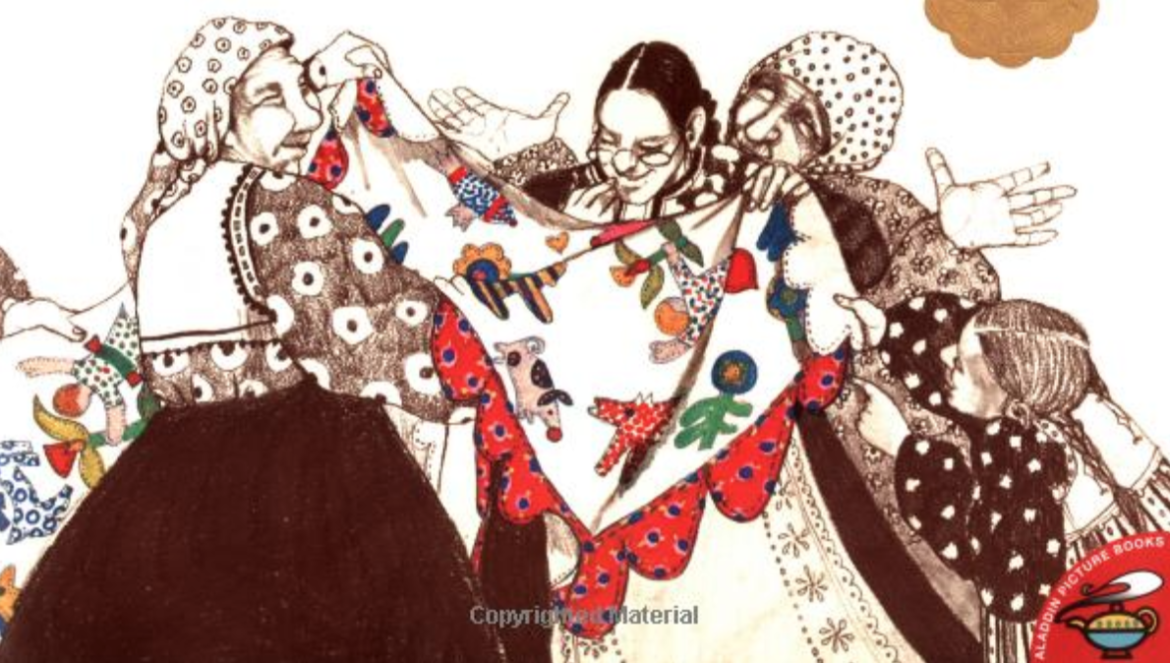
Children’s book author and illustrator Denise Fleming has this to say about what makes a good picture book:
1. Rhythm in both text and art.
2. A tight text rich in language.
3. Use of repetition or refrain which encourages the listeners to
participate.
4. A sense of playfulness and joy.
5. And rhyme, when it works, is a plus.
Sort of sounds like what makes a good quilt, doesn’t it? Okay, so instead of tight text, I guess we should substitute tight stitches, but otherwise, I’m sold.
It’s not surprising that quilts frequently appear in children’s books. Quilts bring to mind comfort and being comforted; they’re an emblem of home.
And there’s something elemental about a quilt. Sometimes I think we mis-remember childhood as being simple (it’s not) because when we’re young, the pieces of our lives are few. There’s home, there’s the dog that lives across the street, there’s the car, there’s the shopping center. As we get older, we accumulate experiences, responsibilities, and debts of all sorts. Things get complicated.
But the quilt your mom pulls out of the linen closet when you’re five and you’ve got the flu isn’t complicated at all; it’s essential. (Just like your mom.)
The quilt in Grandmother Winter is a very special quilt, although some of the quilters among us might wonder if a quilt stuffed with goose feathers (as Grandmother Winter’s quilt is) wouldn’t more accurately be called a duvet. No matter; the fact is, it wouldn’t be the same story if, after spending summer and fall collecting feathers from her flock of geese, Grandmother Winter shook her duvet over the town to make it snow.
No, it’s much better to read,
When Grandmother shakes her quilt
children come running from their homes,
catching snowflakes cold on their tongues.
Grown-ups build their woodpiles high
and scurry for sweaters, mittens and skis.

Grandmother Winter (Houghton-Mifflin, 1999) was written by Phyllis Root and illustrated by the marvelous Beth Krommes. It’s a perfect read for when the snow starts to fall.
I’m a quilter, and I assume most of you reading this are quilters, too. Many of us live in houses virtually overrun by quilts (and I say, keep ’em coming!). But in some families, quilts are rare. In fact, if there’s a quilt at all, it’s often one that’s been passed down from generation to generation, a prized heirloom only taken out for special occasions.
In Patricia Palacco’s family, the heirloom quilt was made soon after Palacco’s great-grandmother, Anna, a Russian immigrant, arrived in the U.S. as a girl. In Palacco’s book, The Keeping Quilt, we learn that the quilt began its life as Anna’s babushka, Uncle Vladimir’s shirt, and Aunt Havalah’s nightdress, which were cut into animals and flowers and appliqued onto a white background.
The quilt serves over the years as the sabbath table tablecloth, a ground cover for picnics, and when Great-Grandma Anna marries Great-Grandfather Sasha, the quilt becomes a wedding huppa. The quilt is passed down to Grandma Carle, to Palacco’s mother Mary Ellen, and eventually to Palacco, who one day will pass the quilt onto her own daughter, Traci Denise.

Patricia Palacco is one of my favorite children’s book writers and illustrators. If I could draw, I would want to draw exactly the way she does. The illustrations in The Keeping Quilt are lively in spite of the fact that except when depicting the quilt itself, all the drawings are in shades of brown.
If you would like to hear The Keeping Quilt read as you look at the pictures, watch this YouTube video.
The Keeping Quilt by Patricia Polacco (Aladdin Paperbacks/Simon & Schuster, 1988)
Finally for today, we have Sam Johnson and the Blue Ribbon Quilt by Lisa Campbell Ernst. Set in a small farming community, in an unspecified, way-back time, Sam Johnson and the Blue Ribbon Quilt is a sweet story of a man who discovers the joy of stitching. Sam wants to join his wife’s quilting bee, but is soundly rejected (“‘Don’t be silly,’ the club president said. ‘We can’t have a man here bungling everything!'”). Sam convinces the men of the community to start their own quilting bee and to make a quilt to compete against the women’s in the County Fair.
This is a light, lively book with folksy illustrations that mirror the story’s tone. A note at the end of the book informs the reader that the border designs for each picture are actual quilt patterns and then gives the names in order of their appearance. Very fun!

Sam Johnson and the Blue Ribbon Quilt by Lisa Campbell Ernst (Lothrop, Lee & Shepard Books, 1983).
Stay tuned for Part II of Quilts in Children’s Books, where we’ll take a look at that beloved myth: the use of quilts in the Underground Railroad.



